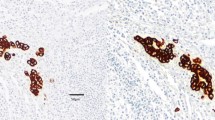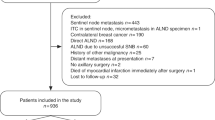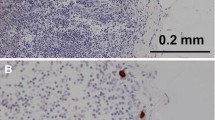Abstract
PURPOSE: Lymph node metastasis in colorectal carcinoma is an important prognostic factor, yet the prognostic relevance of occult tumor cells in lymph nodes has not elucidated. This study was performed to investigate the correlation between isolated tumor cells in lymph nodes and malignancy potential in patients with Dukes B colorectal carcinoma and, thus, to determine whether presence of isolated tumor cells in lymph nodes has a prognostic significance. METHODS: To evaluate the incidence of isolated tumor cells in lymph nodes in patients with Dukes B colorectal carcinoma, 1,808 lymph nodes taken from 93 patients (19.4 per case) were assessed by immunohistochemical technique using a monoclonal antihuman cytokeratin (MNF 116). Clinicopathologic parameters and prognosis were compared between patients with and without isolated tumor cells. RESULTS: Isolated tumor cells were identified in 54 lymph nodes from 29 patients (31.2 percent) by the immunostaining. No correlations were observed between the incidence of positive isolated tumor cells and various clinicopathologic parameters, including preoperative carcinoembryonic level, tumor site and size, histologic differentiation, pT stage, vascular invasion and lymphatic invasion, and perineural invasion. There was no difference in five-year survival estimated by Kaplan-Meier life-table method between positive and negative groups for isolated tumor cells (82.8 and 85.9 percent, respectively). Multivariate analyses showed that sex (P = 0.0236), serum carcinoembryonic level (≥ 5 ng/ml, P = 0.0002), and lymphatic vessel invasion (P = 0.0002) were significant factors in the survival time. CONCLUSION: Immunohistochemical staining with an anticytokeratin antibody is useful in identifying isolated tumor cells in lymph nodes missed in routine hematoxylin-eosin staining, but clinically it seems to be of little prognostic value in patients with Dukes B colorectal carcinoma. Thus, this immunostaining technique does not offer a significant benefit of different strategies for additional therapy or follow-up during conventional pathologic staging using hematoxylin-eosin staining.
Similar content being viewed by others
References
CE Dukes HJ Bussey (1958) ArticleTitleThe spread of rectal cancer and its effect on prognosis Br J Surg 12 309–312
JR Jass WS Atkin J Cuzick (1986) ArticleTitleThe grading of rectal cancer Histopathology 10 437–459
G Lindmark B Gerdin L Påhlman R Bergström B Glimelius (1994) ArticleTitlePrognostic predictors in colorectal cancer Dis Colon Rectum 37 1219–1227
AM Cohen S Tremiterra F Candela HT Thaler ER Sigurdson (1991) ArticleTitlePrognosis of node-positive colon cancer Cancer 67 1859–1861
P Hermanek (1995) ArticleTitlepTNM and residual tumor classifications World J Surg 19 184–190
R Moll WW Franke DL Schiller B Geiger R Krepler (1982) ArticleTitleThe catalog of human cytokeratins Cell 31 11–24
F Lindemann G Schlimok P Dirschedl J Witte G Riethmuller (1992) ArticleTitlePrognostic significance of micrometastatic tumour cells in bone marrow of colorectal cancer patients Lancet 340 685–689
M Trojani I de Mascarel JM Coindre F Bonichon (1987) ArticleTitleMicrometastases to axillary lymph nodes from invasive lobular carcinoma of breast Br J Cancer 56 838–839
DD Sedmak TA Meineke DS Knechtges (1989) ArticleTitleDetection of metastatic breast carcinoma with monoclonal antibodies to cytokeratins Arch Pathol Lab Med 113 786–789
J Cai M Ikeguchi M Maeta N Kaibara (1999) ArticleTitleMicrometastasis in lymph nodes and microinvasion of the muscularis propria in primary lesions of submucosal gastric cancer Surgery 126 32–39
Y Maehara T Oshiro K Endo (1996) ArticleTitleClinical significance of occult micrometastasis lymph nodes from patients with early gastric cancer who died of recurrence Surgery 119 397–402
K Ishida T Katsuyama A Sugiyama S Kawasaki (1997) ArticleTitleImmunohistochemical evaluation of lymph node micrometastases from gastric carcinomas Cancer 79 1069–1076
JK Greenson CE Isenhart R Rice C Mojzisik D Houchens EW Martin SuffixJr (1994) ArticleTitleIdentification of occult micrometastases in pericolic lymph nodes of Dukes B colorectal cancer patients using monoclonal antibodies against cytokeratin and CC49. Correlation with long-term survival Cancer 73 563–569
MD Jeffers GM O’Dowd H Mulcahy (1994) ArticleTitleThe prognostic significance of immunohistochemically detected lymph node micrometastases in colorectal carcinoma J Pathol 172 183–187
R Cutait VAF Alves LC Lopes (1991) ArticleTitleRestaging of colorectal cancer based on the identification of lymph node micrometastases through immunoperoxidase staining of CEA and cytokeratins Dis Colon Rectum 34 917–920
BR Davidson VR Sams J Styles C Deane PB Boulos (1990) ArticleTitleDetection of occult nodal metastases in patients with colorectal carcinoma Cancer 65 967–970
R Broll V Schauer H Schimmelpenning (1997) ArticleTitlePrognostic relevance of occult tumor cells in lymph nodes of colorectal carcinomas Dis Colon Rectum 40 1465–1471
G Adell B Boeryd B Frånlund R Sjödahl L Håkansson (1996) ArticleTitleOccurrence and prognostic importance of micrometastases in regional lymph nodes in Dukes B colorectal carcinoma Eur J Surg 162 637–642
angst Öberg R Stenling B Tavelin G Lindmark (1998) ArticleTitleAre lymph node micrometastases of any clinical significance in Dukes Stages A and B colorectal cancer? Dis Colon Rectum 41 1244–1249
M Sasaki H Watanabe JR Jass (1997) ArticleTitleOccult lymph node metastases detected by cytokeratin immunohistochemistry predict recurrence in “node-negative” colorectal cancer J Gastroenterol 32 758–764
N Mantel (1966) ArticleTitleEvaluation of survival data and two new rank order statistics arising in its consideration Cancer Chemother Rep 50 163–170
DR Cox (1972) ArticleTitleRegression models and life tables J Royal Stat Soc 34 187–220
IC Talbot S Ritchie MH Leighton AO Hughes HJ Bussey BC Morson (1980) ArticleTitleThe clinical significance of invasion of veins by rectal cancer Br J Surg 67 439–442
P Hermanek RV Hutter LH Sobin C Wittekind (1999) ArticleTitleInternational Union Against Cancer. Classification of isolated tumor cells and micrometastasis Cancer 86 2668–2673
P Hermanek (1999) ArticleTitleDisseminated tumor cells versus micrometastasis Anticancer Res 19 2771–2774
M Mori K Mimori H Inoue (1995) ArticleTitleDetection of cancer micrometastases in lymph nodes by reverse transcriptase-polymerase chain reaction Cancer Res 55 3417–3420
N Hayashi I Ito A Yanagisawa (1995) ArticleTitleGenetic diagnosis of lymph-node metastasis in colorectal cancer Lancet 345 1257–1259
N Yamamoto Y Kato A Yanagisawa H Ohta T Takahashi T Kitagawa (1997) ArticleTitlePredictive value of genetic diagnosis for cancer micrometastasis Cancer 80 1393–1398
JL Mansi U Berger D Easton (1987) ArticleTitleMicrometastases in bone marrow in patients with primary breast cancer BMJ 295 1093–1096
AJ Cochran DR Wen HR Herschman (1984) ArticleTitleOccult melanoma in lymph nodes detected by antiserum to S-100 protein Int J Cancer 34 159–163
Author information
Authors and Affiliations
About this article
Cite this article
Choi, HJ., Choi, YY. & Hong, SH. Incidence and Prognostic Implications of Isolated Tumor Cells in Lymph Nodes from Patients with Dukes B Colorectal Carcinoma. Dis Colon Rectum 45, 750–755 (2002). https://doi.org/10.1007/s10350-004-6291-0
Issue Date:
DOI: https://doi.org/10.1007/s10350-004-6291-0




